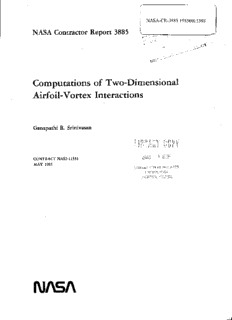
Computations of Two-Dimensional Airfoil-Vortex Interactions PDF
Preview Computations of Two-Dimensional Airfoil-Vortex Interactions
https://ntrs.nasa.gov/search.jsp?R=19850015398 2019-01-03T16:05:32+00:00Z NASA Contractor Report 3885 NASA-CR-3885 19850015398 f / r Computations of Two-Dimensional Airfoil-Vortex Interactions Ganapathi R. Srinivasan " ! i-}rl ?. it3 <¢! :5 , CONTRACT NAS2-11331 i,_\'<{ ). ]',2'_!i_ MAY 1985 jY',NGLL';'i<ESE?,!{C__,CU'._rE2 L1ur_A!,TY,_,_?,SA NASA Contractor Report 3885 Computations of Two-Dimensional Airfoil-Vortex Interactions Ganapathi R. Srinivasan Flow Simulations, Inc. Sunnyvale, California Prepared for Aeromechanics Laboratory USAAVSCOM Research and Technology Laboratories and NASA Ames Research Center under Contract NAS2-11331 N/ A NationalAeronautics and SpaceAdministration ScientiticandTechnical IntormationBranch 1985 FOREWORD The research reported in this document was performed for NASA,Ames Research Center and U. S. Army Aeromechanics Laboratory (AVSCOM)by Flow Simulations, Inc., Sunnyvale, California under Contract NAS2-11331. During the period of performance of this contract Drs. P. Kutler and W. J. McCroskey were the Technical Monitors. Drs. J. L. Steger, T. H. Pulliam and P. G. Buning provided some help- ful suggestions during this investigation. Also, special thanks are due to Dr. P. G. Buning for his help in displaying computed results using his three-dimensional plot package. Results of Transonic Small Disturbance calculations were provided by Dr. W. J. McCroskey. iii iv SUMMARY This report presents a numerical solution procedure to calculate the interaction of a vortex with a two-dimensional airfoil in a uniform free stream and results for several test cases. A Lamb-like analytically prescribed vortex with a finite core, either fixed at one location in the flowfield or convecting with the free stream, interacts with the flowfield of an airfoil madeup of NACA0012 or NACA64A006 profile in transonic or subsonic free stream. Both Euler and thin-layer Navier-Stokes solutions are computed using perturbation form of an implicit noniterative numerical algorithm. Euler and thin-layer Navier-Stokes solutions are compared with the solutions from transonic small disturbance formulation (ATRAN2)and experimental results where they are available. Most of the interactions considered in this study are strong, in the sense that the vortex produced significant and nonlinear distortions of the flowfield, but relatively weak in the sense that they are within the scope of the transonic small disturbance assumptions. For such interactions, the three methods gave qualitatively similar results. For the stronger interactions considered, in the sense of exceeding the small disturbance assumptions limit, Euler and thin-layer Navier-Stokes solutions are computed. Comparison of thin-layer Navier-Stokes solution with a test case of recent Army Aeromechanics Laboratory experiments on a two-bladed heli- coptor rotor shows a good agreement with the surface pressure distribution. The location of the shock wave is predicted slightly downstream of the experimental observation which implies that the time-lag effects of the free stream velocity approaching the blade may be important and should be V considered in the analyses. In general, the results show a tremendous influence of the interacting vortex on the flowfield around the airfoil. This is particularly true when the vortex is stationary. For a convecting vortex, the most dramatic changes in the airfoil flowfield seem to occur when the vortex is within one chord of the airfoil. vi TABLEOFCONTENTS SECTION PAGE FORWARD iii SUMMARY v LIST OFSYMBOLS ix LIST OF FIGURES xiii 1 INTRODUCTION 1 2 NUMERICALFORMULATIONS 4 2.1 Governing Equations 4 2.2 Boundary and Initial Conditions 7 2.3 Grid Generation 10 2.4 Numerical Algorithm 11 2.5 Transonic Small Disturbance Formulation 13 2.6 Transonic Small Disturbance Calculations in the 15 Leading-Edge Region 3 RESULTSANDDISCUSSION 18 3.1 Baseline Solutions 19 3.2 Vortex Interaction in Transonic Flow 20 3.2.1. Interaction of a Vortex with NACA0012 Airfoil 20 (a) Vortex Fixed in Space 20 (b) Vortex Convecting with the Flow 21 3.2.2. Interaction of a Vortex with NACA64A006 Airfoil 23 (a) Vortex Convecting in a Prescribed Path 24 (b) Vortex Convecting in a Force Free Path 28 3.3 Vortex Interaction in Subcritical and Subsonic Flow 29 3.4 Preservation of Vortex by Perturbation Scheme 30 4 CONCLUDINGREMARKS 32 REFERENCES 34 FIGURES 37 vii viii
Description: